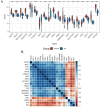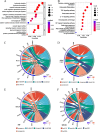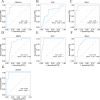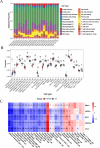Construction and validation of a senescence-related gene signature for early prediction and treatment of osteoarthritis based on bioinformatics analysis
- PMID: 39738612
- PMCID: PMC11686076
- DOI: 10.1038/s41598-024-83268-9
Construction and validation of a senescence-related gene signature for early prediction and treatment of osteoarthritis based on bioinformatics analysis
Abstract
The aim of this study is to screen key target genes of osteoarthritis associated with aging and to preliminarily explore the associated immune infiltration cells and potential drugs. Differentially expressed senescence-related genes (DESRGs) selected from Cellular senescence-related genes (SRGs) and differentially expressed genes (DEGs) were analyzed using Gene Ontology enrichment, Kyoto Encyclopedia of Genes and Genomes (KEGG) pathways and protein-protein interaction networks. Hub genes in DESRGs were selected based on degree, and diagnostic genes were further screened by gene expression and receiver operating characteristic (ROC) curve. CIBERSORTx and ssGSEA algorithms were then used to assess immune cell infiltration and to analyse the correlation between key DESRGs and immune infiltration. Finally, a miRNA-gene network of diagnostic genes was constructed and targeted drug prediction was performed. Combined with the DEGs and SRGs, we screened 19 DESRGs for further study. Five diagnostic genes were ultimately identified: CDKN1A, VEGFA, MCL1, SNAI1 and MYC. ROC analysis showed that the area under the curve (AUC). Correlation analysis showed that the five hub genes were closely associated with neutrophil, plasmacytoid dendritic cell, activated CD4 T-cell and type 2 T-helper cell infiltration in the development of Osteoarthritis (OA). Finally, we found that drugs such as lithium chloride, acetaminophen, curcumin, celecoxib and resveratrol could be targeted for the treatment of senescence-related OA. The results of this study indicate that CDKN1A, VEGFA, MCL1, SNAI1, and MYC are key biomarkers that can be used to predict and prevent early aging-related OA. Lithium chloride, acetaminophen, curcumin, celecoxib, and resveratrol can be used for personalized treatment of aging-related OA.
Keywords: Bioinformatics; Immune Infiltration; Osteoarthritis; Senescence; Senescence-related genes.
© 2024. The Author(s).
Conflict of interest statement
Declarations. Competing interests: The authors declare no competing interests.
Figures









Similar articles
-
The role of senescence-related hub genes correlating with immune infiltration in type A aortic dissection: Novel insights based on bioinformatic analysis.PLoS One. 2025 Jun 25;20(6):e0326939. doi: 10.1371/journal.pone.0326939. eCollection 2025. PLoS One. 2025. PMID: 40561071 Free PMC article.
-
Identification and validation of senescence-related genes in circulating endothelial cells of patients with acute myocardial infarction.Front Cardiovasc Med. 2022 Dec 13;9:1057985. doi: 10.3389/fcvm.2022.1057985. eCollection 2022. Front Cardiovasc Med. 2022. PMID: 36582740 Free PMC article.
-
Identification and validation of cellular senescence-related genes and immune cell infiltration characteristics in intervertebral disc degeneration.Front Immunol. 2025 May 29;16:1589849. doi: 10.3389/fimmu.2025.1589849. eCollection 2025. Front Immunol. 2025. PMID: 40510349 Free PMC article.
-
Identification and Validation of CDKN1A and HDAC1 as Senescence-Related Hub Genes in Chronic Obstructive Pulmonary Disease.Int J Chron Obstruct Pulmon Dis. 2022 Aug 10;17:1811-1825. doi: 10.2147/COPD.S374684. eCollection 2022. Int J Chron Obstruct Pulmon Dis. 2022. PMID: 35975032 Free PMC article.
-
The role of microRNAs in cellular senescence and age-related conditions of cartilage and bone.Acta Orthop. 2015 Feb;86(1):92-9. doi: 10.3109/17453674.2014.957079. Epub 2014 Sep 1. Acta Orthop. 2015. PMID: 25175665 Free PMC article. Review.
Cited by
-
Association analysis between nutritional factors within the genome and the risk of osteoarthritis.Front Nutr. 2025 Jun 13;12:1592974. doi: 10.3389/fnut.2025.1592974. eCollection 2025. Front Nutr. 2025. PMID: 40584103 Free PMC article.
-
The Mechanism by Which Estrogen Level Affects Knee Osteoarthritis Pain in Perimenopause and Non-Pharmacological Measures.Int J Mol Sci. 2025 Mar 7;26(6):2391. doi: 10.3390/ijms26062391. Int J Mol Sci. 2025. PMID: 40141035 Free PMC article. Review.
References
-
- Mobasheri, A. & Batt, M. An update on the pathophysiology of osteoarthritis. Ann. Phys. Rehabil. Med.59(5–6), 333–339 (2016). - PubMed
-
- Van der Kraan, P. M. & Van den Berg, W. B. Osteophytes: relevance and biology. Osteoarthr. Cartil.25(12), 203–204 (2017). - PubMed
-
- Blanco, F. J., Rego, I. & Ruiz-Romero, C. The role of mitochondria in osteoarthritis. Nat. Rev. Rheumatol.17(1), 11–27 (2021). - PubMed
-
- Appleton, C. T. Osteoarthritis year in review 2017: biology. Osteoarthr. Cartil.26(3), 293–300 (2018). - PubMed
Publication types
MeSH terms
Substances
Grants and funding
LinkOut - more resources
Full Text Sources
Medical
Research Materials

